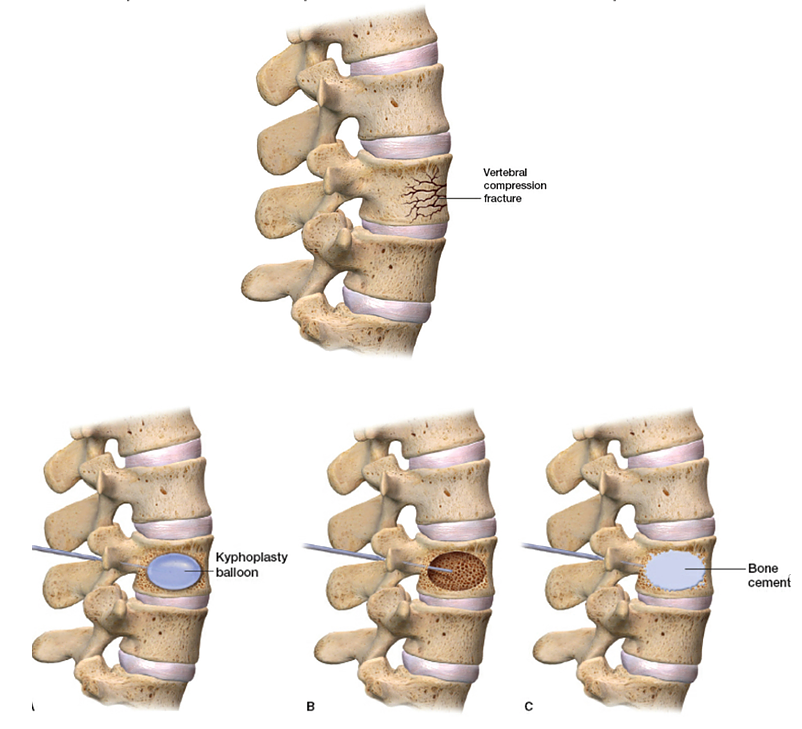What is a Kyphoplasty?
A Kyphoplasty is a procedure that is performed for compression fractures of the spine. This is where your doctor takes surgical glue and fixes a fracture through the skin without a surgical incision. This is achieved by large needles which are used to drill into the broken bone in which bone cement is injected through. This is the same-day procedure and many times gives immediate relief.
Why perform a kyphoplasty?
A kyphoplasty is performed to stabilize a compression fracture of the spine as well as decrease kyphosis which is the hunching forward of the back. Previously patients were given a back brace and told to wait and let it heal naturally. Many people experience chronic pain from even healed fractures and this is where kyphoplasty can be beneficial.
Can anyone have a kyphoplasty?
A kyphoplasty is a procedure that is determined by your doctor if it is appropriate. If you have any weakness in her lower extremities after a compression fracture you’re most likely not a candidate. If you have any localized infection, such as a skin infection on the knee, or a generalized infection, the procedure would not be performed until the infection has cleared up.

The procedure is done under live X-ray to ensure that the injection is given in the correct place. If you are female and below the age of 55 you will be asked about the date of your last period, and you may be asked whether you are likely to be pregnant. Although the amount of radiation used is small, there is always a risk to the fetus with radiation. Occasionally we may need to ask you to have a pregnancy test.
What are the risks and complications?
Kyphoplasty has risks associated with the tunneling and the placement of bone cement. There is a possibility of damage to the bone and other structure around the kyphoplasty including the spinal cord. There is a possibility of allergic reaction the the bone cement as well as a blood clot from the bone cement. The risks of this procedure include paralysis and death however this is uncommon.
Infection is always a risk whenever anything is injected into the body, and we take precautions to avoid this by performing the procedure as a fully sterile technique. If an infection does occur it can produce the symptoms of feeling unwell, headache, and stiffness of the neck. This can occur quite soon after the injection.
There is the possibility of an abscess forming in the epidural space, which may occur after two or three days, and would give rise to pain in the back and worsening pain in the extremities. Similar symptoms may occur if there is a blood clot within the epidural space. This is more likely to occur if you are taking medicines to thin the blood. Overall, these complications are extremely rare. However, if you start to suffer from any of these symptoms, you must go and see your doctor or the Emergency Room of your local hospital urgently (do not go to Urgent Care), and inform them that you have had an epidural injection
How is the procedure performed?
The procedure is performed in the operating room or office under live X-ray. When you arrive a small needle may be inserted into one of your veins, for safety, so that should any drugs be required, they can be easily given. You will be expected to lie on the table face down.
Local anesthetic is injected into the skin and deeper tissues to reduce the discomfort of the procedure. However, when the needle is inserted there will be a feeling of someone pushing in your back or neck, which is normal. When the operator has put the needle in, X-rays will be taken to confirm that the needle is correctly positioned. When the operator has confirmed that the needle is in the correct place, the bone cement will be given and the introducer needle removed.
What happens after the procedure?
After the procedure you will go into the recovery area where your blood pressure will be monitored. As local anesthetic is normally used as part of the injection technique, you may notice some numbness or weakness of your legs. This is only a temporary problem, which will wear off. Therefore you will not be allowed to go home until you have full sensation in your legs.
What pain might you experience after the procedure?
The amount of pain experienced might become worse for a short period of time. If this occurs, it is not dangerous and should settle over time.
Back at home
You can remove the dressing from the injection site after 24 hours.
Will you be followed up afterwards?
You will be called for follow up to determine how the epidural has helped you.
Important information
Please let us know before if you have:
- A cold/flu
- Fever/chills
- A persistent cough
- You are taking a course of antibiotics prior to procedure Or there has been any significant change in your overall health as this may affect your procedure.
Failure to do so may result in your procedure being cancelled on the day.
Medication
Please take all your prescribed medication as normal prior to your procedure unless you have been otherwise advised
Please bring a list of all your current medication when you attend your procedure
Can I eat before I come in?
If you plan to get sedation for the procedure you should not eat from midnight the night before.
If you have any questions or concerns about this procedure call the office at 480-444-7480

